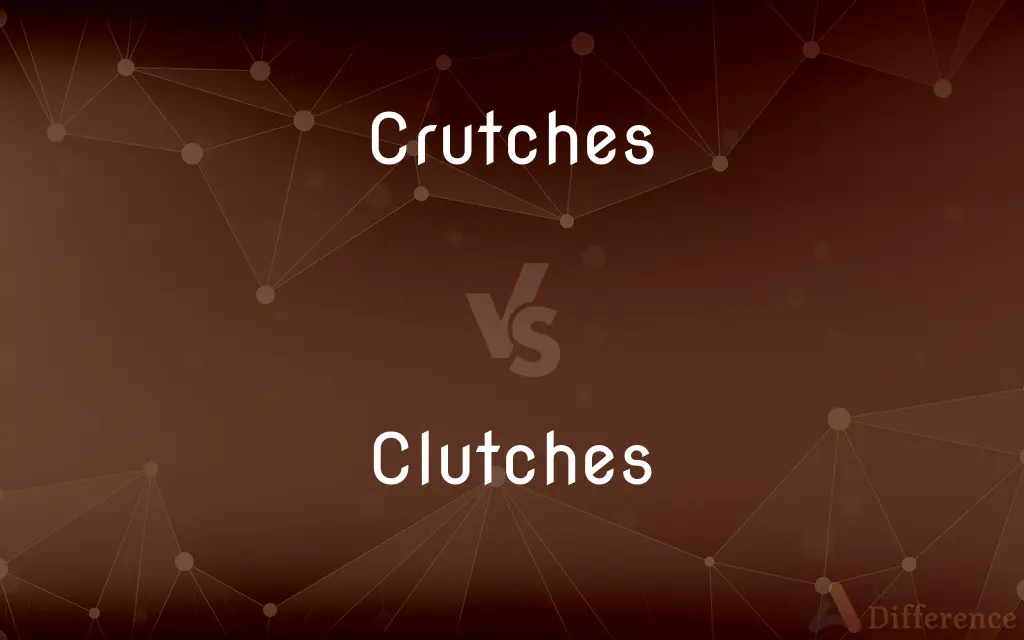Crutches vs. Clutches — What's the Difference?
By Tayyaba Rehman & Urooj Arif — Updated on April 22, 2024
Crutches support mobility after an injury by transferring weight from the legs to the upper body, whereas clutches engage or disengage power transmission in vehicles.

Difference Between Crutches and Clutches
Table of Contents
ADVERTISEMENT
Key Differences
Crutches are medical devices used to aid individuals who have difficulty walking due to an injury or disability. They are designed to transfer weight from the legs to the upper body, thus supporting mobility. On the other hand, clutches are mechanical devices found in vehicles that help in engaging or disengaging the power transmission from the engine to the drivetrain.
Crutches typically come in various forms such as underarm, forearm, and platform styles, each catering to different needs and preferences for comfort and stability. Whereas, clutches are generally of two types: manual and automatic, each type designed to suit the driving style and the mechanics of the vehicle.
The main function of crutches is to reduce the load on an injured limb and to assist in the balance and walking of the user. Meanwhile, the primary role of a clutch is to allow the engine to continue running without driving the wheels when the vehicle is stationary, and to smoothly transfer engine power when the vehicle is in motion.
Using crutches involves physical effort by the upper body to lift and move forward, which requires strength and coordination. Conversely, operating a clutch involves the use of a pedal in manual transmission vehicles, requiring coordination between the clutch pedal, the gear lever, and the accelerator.
In terms of materials, crutches are usually made from lightweight metals like aluminum or composites to ensure they are easy to handle yet sturdy enough to support body weight. Clutches, however, are made from a variety of materials including metals and composite fibers to handle the friction and heat generated during their operation.
ADVERTISEMENT
Comparison Chart
Primary Use
Aid in mobility
Control power transmission in vehicles
Types
Underarm, forearm, platform
Manual, automatic
Function
Transfer body weight, assist in mobility
Engage/disengage engine power, manage torque
Operation
Manual effort by upper body
Pedal operation in vehicles
Material
Lightweight metals, composites
Metals, composite fibers
Compare with Definitions
Crutches
Supportive devices used for mobility by transferring weight from the legs to the upper body.
After his leg surgery, he used crutches to aid in walking.
Clutches
A mechanical device in vehicles for engaging or disengaging power transmission.
He learned how to operate the clutch smoothly during his driving lessons.
Crutches
A type of crutch with a pad resting under the armpit, supported by the arms.
He adjusted the underarm crutches to fit comfortably under his shoulders.
Clutches
A clutch that operates automatically in vehicles, requiring no pedal activation.
Her new car has an automatic clutch, making driving much easier.
Crutches
Crutches designed for those unable to use traditional handles, featuring a horizontal platform.
Platform crutches are essential for patients with limited hand strength.
Clutches
A clutch that engages by the friction between two surfaces.
Regular wear and tear can affect the efficiency of a friction clutch.
Crutches
Crutches that can be altered in height to fit the user’s size.
She found adjustable crutches crucial as they accommodated her tall frame.
Clutches
A clutch system using hydraulic fluid to operate the clutch mechanism.
The hydraulic clutch provides a smoother transition between gears.
Crutches
Crutches that include a cuff that encircles the forearm for support.
Forearm crutches provided him better control and maneuverability.
Clutches
A type of clutch operated by a pedal in manual transmission vehicles.
The manual clutch requires precise control to avoid stalling.
Crutches
A support used by an injured or disabled person, often in pairs, as an aid to walking, having a vertical shaft that is sometimes forked, a horizontal grip for the hand, and a crosspiece that is positioned under the armpit or a cuff that wraps around the forearm.
Clutches
To grasp and hold tightly
A child clutching a blanket.
Crutches
Something on which one depends, often excessively
A mnemonic crutch.
Clutches
To seize; snatch
Clutched the banana from my hand.
Crutches
A forked support or part.
Clutches
To attempt to grasp or seize
Clutch at a life raft.
Crutches
A forked leg rest on a sidesaddle.
Clutches
To engage or disengage a motor vehicle's clutch.
Crutches
(Archaic)The crotch of a person or animal.
Clutches
To hatch (chicks).
Crutches
To move using a crutch or crutches.
Clutches
A hand, claw, talon, or paw in the act of grasping.
Crutches
To support on a crutch or crutches.
Clutches
A tight grasp.
Crutches
Plural of crutch
Clutches
Often clutches Control or power
Caught in the clutches of sin.
Clutches
A device for gripping and holding.
Clutches
Any of various devices for engaging and disengaging two working parts of a shaft or of a shaft and a driving mechanism.
Clutches
The apparatus, such as a lever or pedal, that activates one of these devices.
Clutches
A tense, critical situation
Came through in the clutch.
Clutches
A small, strapless purse that is carried in the hand.
Clutches
The complete set of eggs produced or incubated at one time.
Clutches
A brood of chickens.
Clutches
A group; a bunch.
Clutches
Being or occurring in a tense or critical situation
Won the championship by sinking a clutch putt.
Clutches
Tending to be successful in tense or critical situations
The coach relied on her clutch pitcher.
Clutches
Plural of clutch
Clutches
Grasp; possession; control.
Clutches
The act of grasping.
Clutches
Control; power; - used in the phrase in one's clutches. Same as clutch{2}.
Clutches
The act of grasping;
He released his clasp on my arm
He has a strong grip for an old man
She kept a firm hold on the railing
Common Curiosities
How does a manual clutch operate?
A manual clutch operates through a pedal that the driver presses to disengage the transmission for gear changes.
Are crutches adjustable?
Yes, most modern crutches are adjustable to fit the height and body structure of the user.
Can crutches be used long-term?
Yes, crutches can be used long-term for chronic conditions or disabilities that impair walking.
How do automatic clutches differ from manual clutches?
Automatic clutches do not require manual pedal operation and work automatically based on the vehicle’s gear system.
Are clutches expensive to replace?
Replacing a clutch can be expensive, depending on the type of clutch and the vehicle model.
What is a hydraulic clutch?
A hydraulic clutch uses hydraulic fluid to transfer pressure from the pedal to the clutch mechanism, aiding smoother operation.
What are crutches used for?
Crutches are used to support mobility in individuals who cannot use one or both legs temporarily or permanently.
What is the primary function of a clutch in a vehicle?
The primary function of a clutch is to engage and disengage the power transmission from the engine to the wheels.
What is a friction clutch?
A friction clutch engages and disengages the engine power through the contact of friction surfaces.
What types of crutches are there?
There are primarily three types of crutches: underarm, forearm, and platform.
How often should a vehicle’s clutch be checked?
It's advisable to check a vehicle’s clutch regularly for wear and tear, typically during routine maintenance.
Can children use crutches?
Yes, there are crutches specifically designed for children, which are lighter and shorter.
What materials are used to make clutches?
Clutches are typically made from a variety of metals and composite materials that can withstand high friction and heat.
Is it difficult to learn to use crutches?
Learning to use crutches effectively can take some practice and adjustment to gain balance and mobility.
What is the advantage of using forearm crutches over underarm crutches?
Forearm crutches provide better control, reduce the risk of nerve damage under the armpits, and are preferred for long-term use.
Share Your Discovery

Previous Comparison
Pelt vs. Fur
Next Comparison
Mononymous vs. MononymouslyAuthor Spotlight
Written by
Tayyaba RehmanTayyaba Rehman is a distinguished writer, currently serving as a primary contributor to askdifference.com. As a researcher in semantics and etymology, Tayyaba's passion for the complexity of languages and their distinctions has found a perfect home on the platform. Tayyaba delves into the intricacies of language, distinguishing between commonly confused words and phrases, thereby providing clarity for readers worldwide.
Co-written by
Urooj ArifUrooj is a skilled content writer at Ask Difference, known for her exceptional ability to simplify complex topics into engaging and informative content. With a passion for research and a flair for clear, concise writing, she consistently delivers articles that resonate with our diverse audience.














































